| Release List | Reviews | Price Search | Shop | Newsletter | Forum | DVD Giveaways | Blu-Ray/ HD DVD | Advertise |
| Reviews & Columns |
|
Reviews DVD TV on DVD Blu-ray International DVDs Theatrical Reviews by Studio Video Games Features Collector Series DVDs Easter Egg Database Interviews DVD Talk TV DVD Talk Radio Feature Articles Columns Anime Talk DVD Savant HD Talk Horror DVDs Silent DVD
|
DVD Talk Forum |
|
|
| Resources |
|
DVD Price Search Customer Service #'s RCE Info Links |
|
Columns
|
 |
The Good, The Bad |
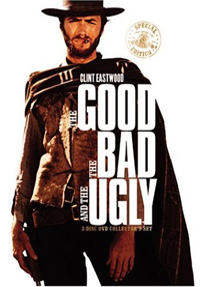
|
The Good, The Bad and The Ugly MGM Home Entertainment 1966 / Color / 2:35 anamorphic 16:9 / 187 min. / Extended Version Collector's Set / Il Buono, Il Brutto, Il cattivo / Street Date May 18, 2004 / 29.98 Starring Clint Eastwood, Lee Van Cleef, Eli Wallach, Aldo Giuffrè, Luigi Pistilli, Mario Brega, Al Mulock, Aldo Sambrell Cinematography Tonino Delli Colli Production Designer Carlo Simi Film Editors Eugenio Alabiso, Nino Baragli Original Music Ennio Morricone Written by Agenore Incrocci, Furio Scarpelli, Luciano Vincenzoni, Sergio Leone, story by Luciano Vincenzoni, Sergio Leone Produced by Alberto Grimaldi Directed by Sergio Leone |
Fifteen years ago Sergio Leone was a cult figure discussed mainly by cinephiles, and his films were popularly known as Spaghetti Westerns or as Clint Eastwood movies. Now Leone's name is familiar to people who've never heard of Howard Hawks or Raoul Walsh. He has eclipsed the fading Sam Peckinpah as the most influential director of action and violence; Quentin Tarantino has called The Good, The Bad and The Ugly "the best-directed movie of all time."
In 1998 MGM released a DVD of GBU that included sixteen minutes of scenes cut from the American version, in the Italian language only. They were a separate extra. That release prompted an effort to create the longest possible version of the film for theatrical presentation; MGM archivist John Kirk prepared the project for years and finally completed it in 2003.
This new "Extended Version Collector's Set" may be a source of controversy among some loyal fans of Sergio Leone. But the average viewer will see and hear big improvements to both picture and track.
I wrote a basic review for The Good, The Bad and The Ugly in 1999 when it was packaged with MGM's 3-pack gift set. My opinion of the film hasn't changed - it's a unique and classic western and easily Sergio Leone's most entertaining film. The cynical doublecrosses of the first two "Dollar" films have aged into a format that also supports sentiment and broad comedy.
With an additional eighteen minutes of new scenes GBU is still the same picture with a redistribution of emphasis. The new material fleshes out the characters of both Eli Wallach's Tuco and Lee Van Cleef's Angel Eyes. There's more melancholy about the slaughter and waste of the Civil War. The longer version patches some gaping continuity gaps as well. This cut brings GBU almost back to its full premiere length in Rome in late 1966. It is longer than any cut released in theaters to paying audiences.
DVD has just turned seven, and many early titles are coming out in "improved" versions. This Extended Version Collector's Set of GBU is both visually improved and 10% longer. Any casual viewer who remembers the film well will be surprised to see a new Clint Eastwood gundown scene in the restored cut.
What's different?
Film-wise, much of GBU was rebuilt from the ground up. With a copy of the full Italian version and a Techniscope negative, MGM archivist John Kirk engaged the film restoration company Triage for the film work. They rematched most of GBU by eye and reprinted a new 35mm 'scope conversion negative. That process is covered in one of the documentaries on the disc but what isn't made clear there is that the negative supplied from Italy had flaws. For some sections of the film it was decided to fall back on a good 35mm American dupe negative instead. You can see some of the problems in the restored scenes: mottling in the sky when Lee Van Cleef arrives at the ruined Rebel fort; yellow staining in the new scene where Tuco and Blondie ride a wagon through a battlefield.
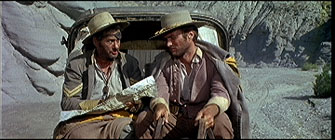
Triage's superior optics greatly improved the picture quality. Techniscope exposes a tiny negative half as tall as a normal film frame. The reason Techniscope looks so sharp is that optical sharpness is much better for non-anamorphic lenses. But the original 60s conversion lenses used to enlarge and squeeze the image back to full 35mm weren't of the greatest quality. Triage uses a custom rig that can focus on more than one axis, and the resulting improvement could be seen at the film's re-premiere last summer.
There are eighteen minutes' worth of new scenes. Sixteen of these are the same standard Italian-only scenes excerpted on the previous DVD (See Savant's original The Good, The Bad and The Ugly Italian version article from 1998 for details on the added Italian scenes). Re-recording English dialogue for the new footage was the biggest "if" in John Kirk's restoration project, and thankfully both Eli Wallach and Clint Eastwood were interested and could make themselves available to dub the new lines. In Clint's case the dubbing didn't take long - he's just as laconic in the cut scenes as he is in the rest of the picture. Actor Simon Prescott imitated the voice of the late Lee Van Cleef.
The acting and voice quality is a reasonable match, although both stars' voices have changed over the years. Eli recreates the gusto of his performance so well we wish he'd come back and play Tuco, aged 90 with Clint in a sequel. Eastwood's voice is thinner but I can't imagine an impersonator doing nearly as well. Prescott's dubbing of Van Cleef varies from scene to scene but essentially is good enough not to draw much attention to itself. It's a bit like Anthony Hopkins providing the missing voice for Sir Laurence Olivier in Spartacus - it sounds a bit like Van Cleef imitating someone else!
The one completely new scene is called The Grotto. In it Tuco recruits three bandits to murder Blondie. This is the only scene not shown in the original Rome engagement in 1966, before GBU was cut to 161 minutes for general release. John Kirk elected to retain The Grotto because producer Grimaldi categorically told him that it was part of the official cut of the film at the Rome Premiere and was dropped from the first release only for time, against the director's wishes. Kirk reinstated it with the producer's blessing. The restored scene fills GBU's most glaring continuity gap. Without the action in the Grotto, the three gunmen who try to ambush Blondie are unmotivated and gratuitous. The scene also presents Tuco as an accomplished manipulator instead of a malcontented loner.
The added material does change the character of the film. Scenes in a fort full of wounded rebels present a more sobering picture of the war. Angel Eyes seems more thoughtful and intelligent, balancing his sadistic villainy elsewhere. Tuco is slightly less clownish and more crafty and clever. Somewhat contrary to the American "Man with No Name" PR image of GBU as a thoroughly cynical action picture, Leone had deeper ideas. Savant's opinion is that the longer version uncovers an essential irony in the film's title. All three of the "magnificent adventurers" are Bad and Ugly - Blondie's relative Goodness is barely perceptable. He simply has a slicker style.
Actually, the film should be a bit longer. There's more than a minute missing from the Tuco Torture Scene (see below). The original Italian release also had an intermission that would have been helpful for the theatrical reissue - Three hours can be a long time between restroom breaks. The original intermission happened in the mission scene, just after the sick Blondie whispers to Tuco and calls him "partner." There's a big time jump across a cut to Tuco walking down the hall much later. That's where the intermission belonged, and it would have been a good touch.
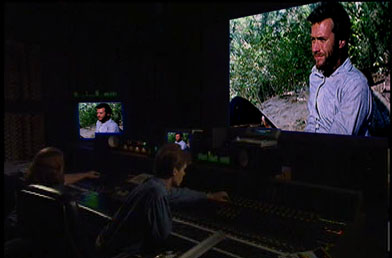
The audio has been remixed. John Kirk's film restoration project was formally proposed in 1998 but had to wait until 2002 when funding became available. The delay was a nervous issue, as it was always possible that Eastwood or Wallach could develop health issues and be unable to revoice their dialogue. 1 The financing finally came from the AMC cable channel, at which time it was decided that part of the work should be to create a new 5.1 mix. As a complete set of discrete audio elements was not available, it became one of those technically complicated efforts where the existing tracks were given a stereo sound through various electronic tricks.
Part of the original buzz on the audio track stemmed from its first AMC showings where bad audio reproduction mixed the channels incorrectly and caused some of the audio to cancel out. The effects were exaggerated and distorted. (This is an opinion gathered from individuals who saw the broadcast - Savant missed it).
The other audio objection was to the sweetening of the gunshot sound effects to beef up the film's recognizable spaghetti "wheeze" rifle cracks, the ones that seem to come from an old Mattel toy Winchester. John Kirk reported that in 5.1 without sweetening, the old gunshots sounded like they were recorded over a telephone. Kirk never had the practical choice of not remixing, and remixing meant making alterations. He did make it clear that this is an 'extended cut' as opposed to a 'director's cut.' This will be The Good, The Bad and The Ugly 2003 the way Apocalypse Now Redux is really Apocalypse Now 2001. The original 1966 American variant of The Good, The Bad and The Ugly will be maintained in parallel with this newer version, as if they were separate films. 3
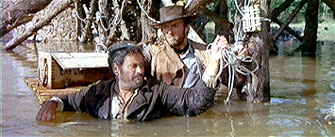
The best thing a studio can do when they've remixed an older soundtrack is to provide an original track as an alternate viewing option. MGM has included the original monaural track, the original Italian mono. Technically and artistically, that is Sergio Leone's original mix and work that he supervised. Detail-oriented fans will discover that the Italian track is more sensitively mixed than the American version, especially when it comes to Ennio Morricone's music score.
MGM's "Extended Version Collector's Set" 2-disc DVD of The Good, The Bad and The Ugly comes in a formidable package. The oversized box opens up to reveal one disc each in the two sides, with some published extras in the middle. Disc one has the feature accompanied by a Richard Schickel commentary. The color is fine, and the encoding is good if not stunning. It's a distinct improvement over the 6 year-old previous release. There's the 5.1 mix re-engineered in 2003 and, on a separate channel, the original monaural Italian track.
Disc 2 2 has the video extras. A new forty-minute docu is split into two parts, Leone's West and Leone's Style. It has lengthy interview material with both Clint Eastwood and Eli Wallach, along with English version supervisor Mickey Knox, producer Alberto Grimaldi, restorer John Kirk and critic Richard Shickel. Wallach tells his favorite stories and shows that he's still as feisty as ever; Eastwood is in a reflective mood, as if he hadn't thought about this period of his career in a long time. Both have fun remembering comical details of the shooting. They relate the story of the bridge scene as one of the funniest (but expensive) filming flubs of all time. Often serious and uncomfortable-looking in old interviews, Eastwood seems to be having a grand time here and his candor is a highlight of the disc set.
Mickey Knox's story of the dubbing is the first time that aspect of these pictures has been described on camera by someone who actually did the work. The actors talk about performing on a noisy set, and then Knox follows with his own memories of inventing good English dubbing dialogue to replace the Italian speaking actors. He had to guess at Eastwood's often ad-libbed lines by endlessly studying the film on a moviola - if there were guide tracks from the set, they'd been tossed.
Then, after Knox had written a script to fit Eastwood's mouth movements, Eastwood showed up at the dubbing studio with his own exact notes of what he really said in each take. Realizing during filming that nobody was doing anything about the problem, Clint had diligently acted as his own script supervisor! With that serious of an attitude, it's no wonder Eastwood became a director.
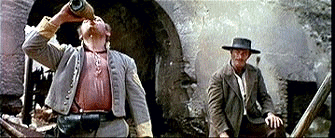
Everyone interviewed had sharp memories of Lee Van Cleef. In halting English, Alberto Grimaldi remembers Leone's appraisal of the gaunt actor with the hawklike gaze: "His eyes ... they burn holes ... in the screen." That's pretty accurate.
The other short subjects concentrate on different aspects of the movie. Variety music critic Jon Burlingame gives us a short illustrated overview of Ennio Morricone's vast contribution, the beautiful and quirky music cues that make the films re-watchable almost to infinity. Much of the discussion is about whether Leone played back temp tracks on the set of GBU to set the mood for scenes. The actors say No but other witnesses say Yes. It's a case of memories going back 40 years to details of things one never intended to remember.
John Kirk and Triage owner Paul Rutan host a Restoration featurette that demonstrates exactly what Techniscope is and looks like, and what makes it so difficult to work with now 30 years after it became obsolete. The closeups of Techniscope side-by side with full 35mm show the main problem: every last shot had to be matched by eye as there were no print-through "key numbers" to guide the editors. The actual film shown being worked on in the close-ups, by the way, is For a Few Dollars More.
The Man Who Lost the Civil War is a cutdown of an originally hour-long docu by Peter Spirer that chronicles the actual skirmishes in West Texas called the Sibley campaign. Many of the place names (Socorro, Apache Canyon) as well as the generals named in GBU are mentioned. Leone exaggerated a lot by adding trench warfare and huge prison camps, but there is a factual basis for the Civil War setting. Although Leone's train-mounted seige cannon is accurate, in the early 1860s there surely weren't any railroads that far West yet!
"Deleted Scenes" contains two items. Tuco Torture is the uncut Italian version of the scene where Mario Brega beats Eli Wallach senseless. It was recut for all versions long ago due to negative damage, which resulted in the soundtrack background being chopped up to fit. The long scene was not re-integrated into the feature on the DVD because the source was an imperfect print. Telecine work can hide many flaws on video, so it doesn't look too bad here. It never would have passed muster for the film finish.
The second deleted scene is a photo-and-text reconstruction of the legendary Socorro Sequence often discussed on Leone web boards. Using a handful of stills and careful descriptions from Leone authors and experts Ulrich Angersbach and Ulrich Bruckner, the piece attempts to give a feel for what the scene was. Alberto Grimaldi said that it was finished but dropped even before the premiere. Snippets from it found their way into a French trailer.
There's also a poster gallery and the original American theatrical trailer.
As extras in the box, we're given a little representation of the original soundtrack album art and four rather beautifully matted mini-posters on heavy card stock. There's also a little insert booklet that reprints Roger Ebert's glowing 2003 reissue review of the movie. Curiously, Ebert remembers not being overwhelmed by GBU back in 1968, when he'd been a film critic for just a year or so.
MGM has an amusing The Good, The Bad and The Ugly Gundown Game website that you might want to visit.
On a scale of Excellent, Good, Fair, and Poor,
The Good, The Bad and The Ugly rates:
Movie: Excellent
Video: Excellent
Sound: Excellent
Supplements: Richard Schickel commentary, Italian mono track, Two new docus Leone's West and Leone's Style, Featurettes The Man Who Lost the Civil War, Reconstructing The Good, The Bad and The Ugly and Il Maestro: Ennio Morricone and The Good, The Bad and the Ugly; uncut Tuco Torture scene, deleted Socorro Scene reconstructed with still photos. Poster Gallery, trailer, GBU mini posters.
Packaging: Unusual oversized box case
Reviewed: April 29, 2004
Footnotes:
1. I've always wanted to do a special edition on Leone's Duck You Sucker. In the last two years both James Coburn and Rod Steiger have passed away, closing the door forever on hearing their stories about that film.
Return
2. Savant edited and helped arrange many of the extras on Disc 2, so keep this in mind when reading my comments - bias is usually obvious to everybody except the biased. I'm not criticizing the disc set here as much as I am elaborating on it.
Return
3. A good argument for the "don't touch a frame" point of view is what happened
to the English versions of the Steve Reeves movie Hercules and Mario Bava's Danger: Diabolik. For one reason or another, some or all of the original dub voices in both movies were re-recorded for video with new talent. What happened to Danger: Diabolik can be read about here. In i>Hercules, Steve Reeves' originally boomy, testosterone-laden baritone was swapped for a guy who sounds more like Eddie Deezen. Half the campy nostalgia of the show was hearing Reeves blast out like a diesel truck horn: "CURSES! I'VE BEEN TRICKED BY THE GODS!" The artistic purity of pop genre pictures is rarely respected, and by any reasonable logic, our concern to protect the integrity of Rodan should be as important as that of Dr. Strangelove. The Good, The Bad and The Ugly is rather in the middle, being both high art and popcorn commerce at the same time. It also generates considerable studio income almost forty years after it was released, a factor that outweighs all others in the reality of DVD.
Return
Review Staff | About DVD Talk | Newsletter Subscribe | Join DVD Talk Forum
Copyright © DVDTalk.com All rights reserved | Privacy Policy | Terms of Use
|
| Release List | Reviews | Price Search | Shop | SUBSCRIBE | Forum | DVD Giveaways | Blu-Ray/ HD DVD | Advertise |





